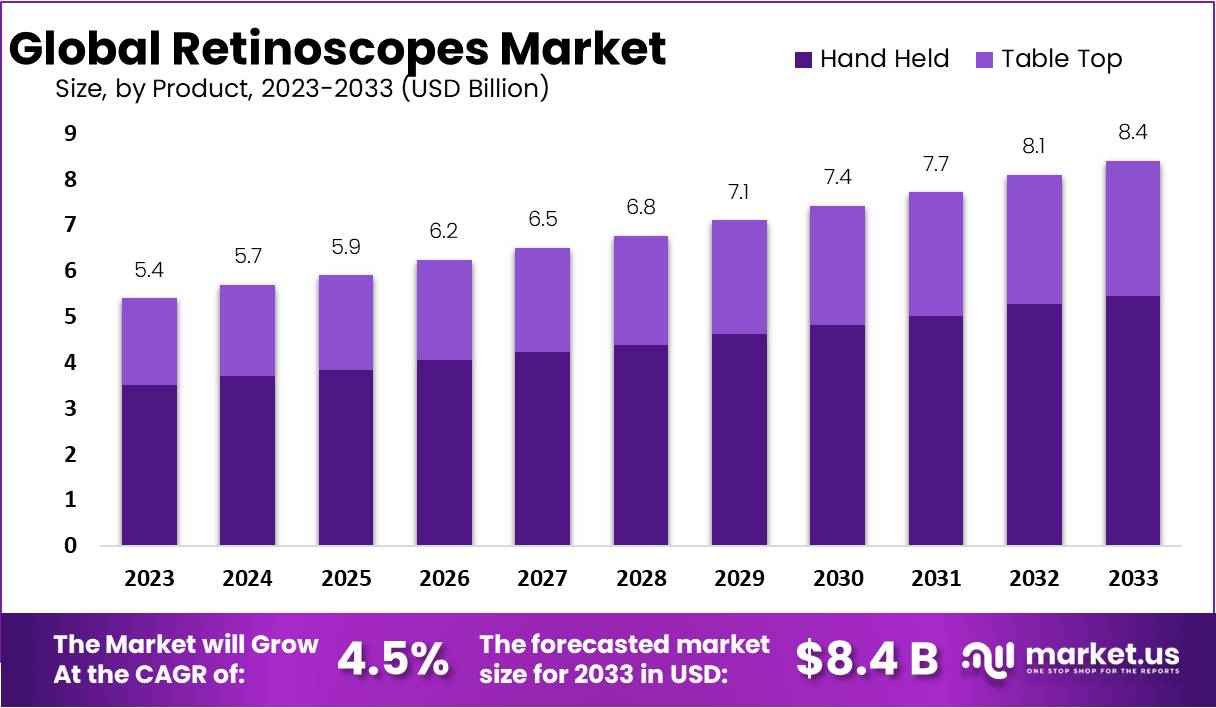Introduction
The Global Retinoscopes Market is projected to grow from USD 5.4 billion in 2023 to USD 8.4 billion by 2033, exhibiting a compound annual growth rate (CAGR) of 4.5%. This growth is primarily driven by advancements in retinoscopy technology, which enhance the precision of refractive error detection crucial for prescribing corrective eyewear.
Technological innovations in retinoscope design, including enhanced illumination systems and improved optical setups, have significantly improved measurement accuracy. These advancements support more precise detection of conditions such as myopia and hyperopia by analyzing light reflected from the retina. Additionally, the increasing prevalence of eye health issues related to aging populations and screen exposure fuels the demand for regular eye examinations, further bolstering the market growth.
Moreover, the development of portable and user-friendly retinoscopes has extended their application beyond traditional clinical settings to field use in remote areas. This adaptability has opened new markets and applications, increasing the commercial appeal and utility of retinoscopic devices in diverse healthcare environments.
Recent market developments include Hillrom’s acquisition of Telemed Corporation’s ophthalmic assets in May 2023, enhancing its eye care technology offerings. Heine Optotechnik introduced the HEINE BETA 520, featuring digital displays and Bluetooth connectivity in September 2023. In November, Oftalmika Medical Equipment partnered with NIDEK CO to strengthen its footprint in the European market with the portable Retinomax K-1. Luneau Technology announced the iLuneau Retino in December 2023, an AI-powered device that provides real-time guidance and data analysis for healthcare professionals. These innovations underline the dynamic expansion and technological progression within the retinoscopes sector.

Key Takeaways
- The Retinoscopes Market is set to expand to USD 8.4 billion by 2033, growing at an annual rate of 4.5% from 2024.
- Hand-held retinoscopes are leading the market with a 65% share, preferred for their ease of use and flexibility in various clinical environments.
- Hospitals are the largest market segment for retinoscopes, holding a 42% share, primarily due to their sophisticated diagnostic capabilities.
- North America holds the majority of the market, with a 51.8% share in 2023, attributed to its robust healthcare systems and prevalent eye conditions.
Emerging Trends
- Integration of Artificial Intelligence (AI): Artificial Intelligence is transforming the field of retinoscopy by improving diagnostic accuracy. AI technologies enable early detection of complex eye conditions such as glaucoma and macular degeneration. This advancement not only enhances the precision of diagnoses but also facilitates timely interventions, potentially saving vision.
- Telemedicine Advancements: Telemedicine is increasingly significant in ophthalmology, particularly for patients who face geographical or physical barriers to clinic visits. This technology supports remote consultations and follow-ups, extending the reach of eye care specialists and ensuring continuous patient care, irrespective of location.
- Smart Eyewear Technology: The development of smart eyewear, including glasses and contacts embedded with sensors, represents a leap forward in eye care. These devices continuously monitor eye health, providing data that can detect diseases early and customize vision correction to suit individual needs, thereby enhancing patient outcomes.
- Myopia Management: The global increase in myopia, especially among children, has spurred the creation of specialized eyewear and lenses. These innovations aim to slow the progression of myopia, offering a proactive approach to managing this widespread condition and improving long-term visual health.
- Digital Eye Strain Solutions: With the surge in digital device usage, addressing digital eye strain is more crucial than ever. Innovations such as blue-light blocking glasses and ergonomic adjustments are becoming mainstream. These solutions help minimize eye discomfort and protect against the effects of prolonged screen time.
- Personalized Eye Care Approaches: Personalized treatment is gaining traction in eye care, with approaches tailored to the unique genetic makeup and lifestyle of each patient. This trend allows for more precise and effective treatment plans, optimizing eye health management and enhancing patient satisfaction.
Use Cases
- Early Disease Detection: Retinoscopes, when enhanced with artificial intelligence, offer a remarkable ability to identify conditions such as diabetic retinopathy at an early stage. This early detection is crucial as it can drastically improve the management and treatment outcomes for various retinal diseases. By catching these conditions sooner, healthcare providers can intervene earlier, potentially saving sight and improving patients’ quality of life.
- Remote Eye Examinations: With the integration of telemedicine capabilities, retinoscopes are transforming the way eye examinations are conducted. They enable eye care professionals to perform remote assessments, diagnosing and recommending treatments without the patient ever having to visit a clinic. This not only makes eye care more accessible but also more convenient, helping to reach patients in remote or underserved areas.
- Educational Tools: In educational environments, retinoscopes are proving invaluable. They are increasingly used to train medical students and new ophthalmologists. These tools provide hands-on experience and real-time feedback, essential for diagnosing a wide range of eye conditions. This practical training helps prepare the next generation of eye care professionals, enhancing their diagnostic skills from the start.
- Enhanced Patient Engagement: Advanced retinoscopes contribute to enhanced patient engagement by providing more accurate diagnostics. When patients understand their conditions better, they tend to trust the process more and follow through with treatments as prescribed. This improved compliance is critical for effective treatment and reinforces the patient’s role in managing their eye health.
Regional Analysis
In 2023, North America maintained a leading position in the Retinoscopes Market, securing over 51.8% market share and reaching a value of USD 2.7 billion. The region’s dominance is underpinned by its advanced healthcare infrastructure, which supports the integration of state-of-the-art retinoscope technology. This infrastructure is pivotal for maintaining high standards in eye care precision.
The commitment to healthcare innovation in North America drives the adoption of sophisticated retinoscopes. This is crucial in addressing the increasing prevalence of eye disorders such as myopia and hyperopia. The market expansion aligns with demographic trends, including an aging population that is more susceptible to eye-related conditions.
The regulatory environment in North America further boosts the Retinoscopes Market. Stringent standards ensure the quality and safety of retinoscope devices, building consumer trust and encouraging market growth. These regulations are vital for sustaining high safety standards and fostering market confidence.
Take advantage of our unbeatable offer - buy now!

Continuous research and development within the region are pivotal for the evolution of retinoscope technology. This ongoing innovation leads to the creation of more advanced and user-friendly models. These developments meet the needs of healthcare professionals and patients alike, ensuring the market’s continuous growth and technological progression.
Conclusion
In conclusion, the global Retinoscopes market is set for substantial growth, fueled by technological advances that enhance diagnostic precision for a range of eye conditions. Innovations in retinoscope design, including improved optical features and portable models, are pivotal in driving market expansion. The integration of Artificial Intelligence and telemedicine further enriches the capabilities of retinoscopes, making eye care more accurate and accessible. North America remains at the forefront of this market, supported by robust healthcare infrastructure and stringent regulatory standards. The ongoing research and adoption of cutting-edge technologies are expected to continue propelling the market forward, ensuring retinoscopes remain essential tools in eye health management.
Discuss your needs with our analyst
Please share your requirements with more details so our analyst can check if they can solve your problem(s)



